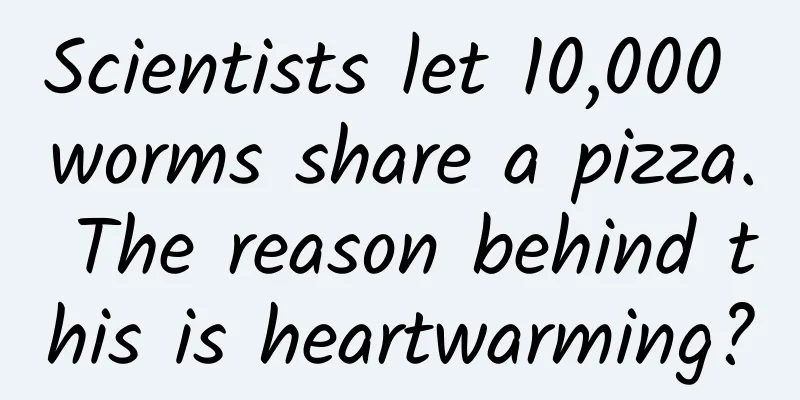Scientists let 10,000 worms share a pizza. The reason behind this is heartwarming?

|
Written by: Qi Zai Layout: Bai Ruobing Excuse me, do you want to know how black soldier fly larvae (commonly known as maggots) eat? Are you interested in watching 10,000 black soldier fly larvae eat pizza together? It is said that they can finish a 16-inch pizza in two hours! ! While doing some extensive reading recently, I came across this amazing and extremely “useless” study: In order to help farmers obtain high-protein chicken feed more quickly, scientists have begun researching how to quickly cultivate black soldier fly larvae. Some companies are known to feed the food waste they collect to swarms of larvae. After eating the rotting leftovers, these maggots can be turned into high-protein feed for animals such as chickens and fish that humans prefer to eat. In this way, a perfect biological cycle is formed: the maggots eat well, the chickens grow stronger, and humans eat high-quality meat. This can be said to be a boon for ecologically sustainable food production. So how to increase the growth rate of maggots has become a key point. As the saying goes, the faster you eat, the faster you grow. Therefore, scientists have conducted in-depth research on the feeding of maggots. The faster the maggots grow, the shorter the time they spend as feed - chickens can get an uninterrupted supply of high-quality protein - and humans can eat high-quality, low-cost meat. In order to study how these maggots eat large amounts of food, the researchers fully recorded the process of black soldier fly larvae devouring orange slices in a transparent glass box at 35°C. The team used software that simulates the movement of fluids to track the flow of individual maggots to look for patterns in the wriggling bodies. Despite the apparent chaos, the larvae's movement is like water being pumped through a fountain, the study said. Hungry maggots are pushed from the bottom toward the food, and satiated maggots are pumped up. (As shown in the picture) Figure | Photo of larvae eating (Source: "Journal of the royal society interface") This "maggot fountain" allows hungry larvae to replace those around them that have stopped eating, keeping the feeding machine going. A better understanding of this process could help companies that cultivate the larvae scale up and turn more food waste into food, the researchers say. Of course, there is actually a rigorous logic behind this incredible research. Previous studies have done a lot of work on collective movement of animals, but most of them are limited to migration, and little is known about collective feeding. In large-scale agricultural collective breeding, many detours have been taken, such as large-scale breeding of pigs, cattle, sheep, chickens, ducks, and fish. It was not until recent years that a breakthrough was made. However, these animals are relatively large and their numbers are under control. In the field of collective insect breeding, it is still in its infancy because the individuals are small and the numbers are large. In this study, scientists made a bold breakthrough in the experimental subjects and chose black soldier fly larvae, which are experts in processing food waste. Figure | Black soldier fly larvae (Source: "Journal of the royal society interface") The black soldier fly larvae used in the experiment were collected from a dirty manure farm, ranging in age from 8 to 12 days and weighing about 0.1 grams. These selected experimental subjects were all extremely dedicated to scientific research: they remained hungry for 24 hours before doing any experiments! During the experiment, a single larvae study and a group of larvae study observation (600 ml, about 3500 larvae) were conducted. Ultra-high-definition Sony handheld camera was used for filming, Matlab was used to complete image digitalization and data extraction, and a particle image velocimeter was used to measure the larval flow velocity. Figure | Particle image velocimetry experimental device (Source: "Journal of the Royal Society Interface") After a series of high-energy analyses, the researchers proposed a mathematical model of the feeding rate of the larval population and analyzed the results. First, we interpret a single larva. The larva has a wedge-shaped body with a black triangular "beak" at the end, which is 0.4 mm long. The beak contains the maxilla, spiracles and mandibular brushes. In an analysis of individual larvae exposed to food, the researchers found that 30 percent of the larvae did not eat. Instead of touching the food, these larvae walked around the perimeter of the container - a mystery that remained unsolved. Figure | Larvae’s mouth (Source: “Journal of the royal society interface”) In the swarm experiment, the larvae were initially distributed in a uniform layer around the orange slice and continued to gather around the slice during the first 5 minutes of the experiment. After the experiment began, the pile was roughly conical, with 8 larvae high at the top and 40 larvae high wide. This form can help the larvae reach the peak feeding rate. (As shown in the picture, put it again) The larvae will rotate the orange slices as they eat them, but this rotation is limited by the container wall, which can speed up the consumption of oranges. There is a relationship between the number of larvae and their feeding rate. After a series of experiments and calculations, when N reaches a certain value, the feeding rate will reach a peak and no longer increase with the increase in the number. Figure | (a) Experimental setup for measuring larval feeding rate; (b) Relationship between feeding rate and number of larvae. Points are experimental data points, and dashed lines are models (Source: "Journal of the royal society interface") In this study, the researchers investigated the feeding methods and processes of black soldier fly larvae in groups and found that the number of larvae that can eat is essentially limited by the surface area of the food. When feeding in small groups, the larvae that are feeding often rest, preventing other larvae from getting food. Groups of larvae overcome this problem by creating a "fountain" around the food, with new larvae crawling in from the bottom and then being "pumped" out the top, forming a feeding "maggot fountain". It has to be said that the intelligence of these little bugs may be far higher than we imagined. Finally, please watch the 5 s feeding video of our larvae friends. It is easy to cause a series of unfriendly physiological reactions! Be careful! Reference Links: https://royalsocietypublishing.org/doi/10.1098/rsif.2018.0735 Source: Academic Headlines |
<<: The last naturalist of the 20th century: lived with ants for 80 years and lived like a child
>>: If I sleep three or four hours today and more than ten hours tomorrow, can I make up for it?
Recommend
How to operate a qualified category?
Category operation is also called product operati...
Testin Crash Analysis Breadcrumb Function Sweepers Crash Problems
The concept of breadcrumbs comes from the fairy t...
Thinner than a cicada's wing and finer than a hair - this metal can be used in industry as well as for food and medicine?
1. Gold Leaf 1.1 Characteristics of gold foil Gol...
Cold waves come one after another. Why are they still so severe amid global warming?
On November 30, the Central Meteorological Observ...
The darker the soy sauce, the better? Three types of people should pay attention when eating soy sauce!
Rumors 1. Eating soy sauce will make your skin da...
What does app operation do? How much does App operation and App development cost?
We often hear many companies say they want to mak...
Unlock the most in-trend advertising methods on Tencent and iQiyi
Effective attention is the starting point of all ...
New fission operation routine: 0 fans leverage 13,000 people + watching live broadcast
The author reviewed a live broadcast fission acti...
How Apple Watch can succeed as Android Wear struggles
[[128623]] Given the current slow development tre...
Two "faces" of submarine volcanoes: magnificent yet ruthless
Iceland has been very restless recently. Since th...
91 Ten Articles: WeRide's valuation exceeds 20 billion, SAIC will launch a battery bank, and Huolala may build cars
1. WeRide raised hundreds of millions of dollars ...
Google's "robot dog" enters service and is tested by the Marine Corps
Google's Legged Squad Support System (LS3) rob...
How to promote APP in 2018? Complete guide to explaining channel promotion!
Whether you are a rookie who has just entered the...
Collection: 68 information flow ads and SEM learning website resources are available for free!
01. CNZZ -UDplus Website: udplus.umeng.com Note: ...
Saved it! A complete collection of commonly used auxiliary tools for APP promotion!
Some people say that App promotion is hard work. ...






![Pan Ya Pan Pan Photography Tutorial 2020 [Good quality only video]](/upload/images/67cc044417e38.webp)


